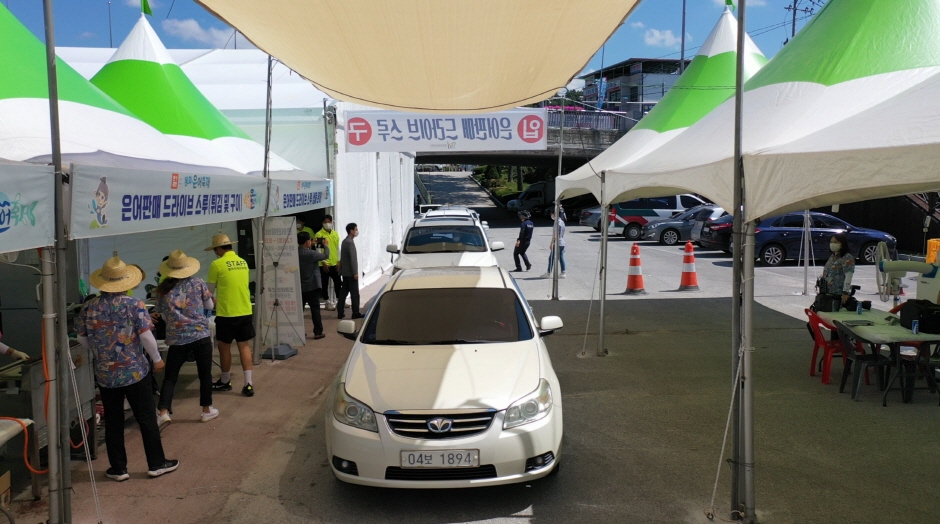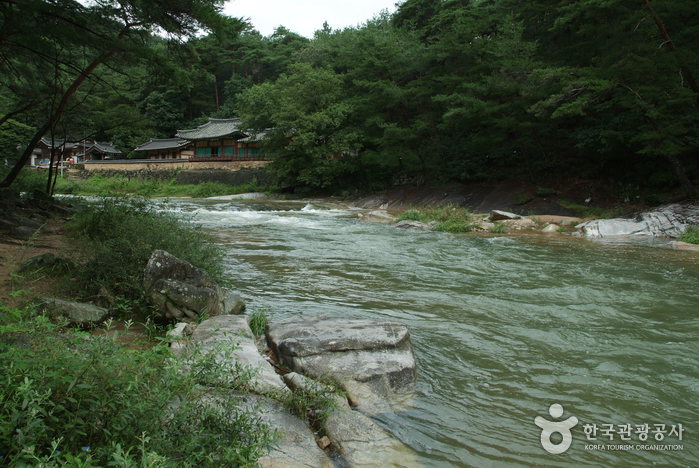Seongamje [Korea Quality] / 성암재 [한국관광 품질인증]
16.9 Km 180 2023-12-01
19-18 , Seodong-gil, Bonghwa-gun, Gyeongsangbuk-do
+82-54-673-5011
Seongamjae in Chunyang-myeon, Bonghwa-gun, Gyeongsangbuk-do, was built in 1915 by Seongam Kang Seung-won, son of Uijae Kang Pil who was an early campaigner for independence from Japan. Built of pinewood, the house is now equipped with modern facilities. In-room cooking is not allowed, a pay-for brunch is available. Next door is Bonghwa Mansan Old House, a National Folk Cultural Asset which guests are free to look around. Chunyang Station on the Yeongdong Line is a 5-minute walk away, and a luggage storage service is available.
Gwonjinsadaek House[Korea Quality] / 권진사댁[한국관광 품질인증]
17.4 Km 0 2023-12-01
39 , Nakcheondang-gil, Bonghwa-gun, Gyeongsangbuk-do
+82-10-9016-3201
Gwonjinsadaek House is a magnificent historic house with a history of more than 130 years, also known as Seongam House located in Chunyang-myeon, Bonghwa-gun, Gyeongsangnam-do. The first thing you notice as you walk inside past the tall gate is the sarangchae (detached building). There four guest rooms, Keun Sarangbang (large room), Jakeun Sarangbang (small room), Saesarangbang (new study room), and Jungbang (medium-sized room), all of which are ondol (underfloor heated) rooms except for Keun Sarangbang. There are no showers, toilets, or cooking facilities inside the rooms. Breakfast is not provided, but rice cakes and tea are complimentary. Nearby tourist attractions include the Mansan House and the East and West Three-Story Stone Pagodas in Seodong-ri, Bonghwa.
Bonghwa Sweetfish Festival (봉화은어축제)
17.9 Km 28434 2023-05-17
Naeseong-ri, Bonghwa-gun, Gyeongsangbuk-do
• 1330 Travel Hotline: +82-2-1330 (Korean, English, Japanese, Chinese) • For more info: +82-54-674-3053
Bonghwa Sweetfish Festival is one of Korea's prime summer festivals and celebrates the local specialty product of sweetfish. The sweetfish from Bonghwa are recorded as having been given as tribute to the king during the Joseon dynasty. The highest-quality sweetfish come from the upstream sections of the Nakdonggang and Seomjingang Rivers, where Bonghwa-gun is located. The festival offers numerous participatory programs including fishing, water play, a water fight, and agricultural experiences. Visitors who participate in fishing activities can feast on their catch.
Andong School of Korean Etiquette (안동예절학교)
18.2 Km 13391 2023-04-07
1333-5, Toegye-ro, Andong-si, Gyeongsangbuk-do
+82-54-841-0511
Andong School of Korean Etiquette, which is located in Andong, is a mecca of Korea's Confucian customs and provides an opportunity to experience traditional Korean etiquette.
In addition to Korean traditional etiquette, Andong School of Korean Etiquette also teaches tea etiquette and traditional Korean music using instruments such as janggu and gayageum. Students can also experience the joy of learning how to play folk games such as yunnori and kite-flying. The school offers a wide variety of hands-on programs related to Korea's traditions and customs such as mask dance, paper craft, cooking, wedding, and eco-rafting on Nakdonggang River.
There are other popular tourist attractions nearby such as Dosanseowon Confucian Academy, Forest Science Museum and Yi Yuk-sa Literary Hall.
Seokcheongyegok Valley (석천계곡)
18.9 Km 13452 2022-09-19
Samgye-ri, Bonghwa-gun, Gyeongsangbuk-do
+82-54-679-6334
Waters from the Taebaek Mountains forged Seokcheongyegok Valley, located in Bonghwa-gun, Gyeongsangbuk-do. The valley is wide, shallow, and surrounded by thick pine forests. Broad, flat rocks are scattered throughout, and the valley is a great place for children to play. Next to the valley, visitors will also find Seokcheonjeong Pavilion, which was built in 1535. This pavilion, made of Bonghwa red pine trees called Chunyangmok, and mounted on stone, offers a great view of the nearby scenic mountain.
Sogang House [Korea Quality] / 소강고택 [한국관광 품질인증]
20.0 Km 5128 2022-03-31
22, Baraemi-gil, Bonghwa-eup, Bonghwa-gun, Gyeongsangbuk-do
+82-10-9189-5578
Located in Baraemi Village, Bonghwa, Gyeongsangbuk-do, Sogang House is a hanok that is over 100 years old. Baraemi Village, the Uiseong Kim clan village, has lots of old houses remaining, but Sogang House has an outstanding history and ambiance. The house was built around 1910 by Namho Kim Roi-sik, a renowned wealthy patriot in Gyeongsang-do, for his second son, Sogang Kim Chang-gi when he was married. Kim Roi-sik is a figure who donated the money secured on his whole possession when the Provisional Government of Korea in Shanghai was raising contributions, and received the Order of Merit for National Foundation. Sogang House is a D-shaped hanok with the adjoining sarangchae and anchae. Even the door frame of the house is built with the chunyang pine, showing the elaboration put in its building. As it is not easily twisted or rotten, chunyang pine is the best pine for architecture that was used for building the palace, the temple, and houses of aristocrats in the Joseon period. There are six guest rooms, including Sarangbang and Eosabang. Sarangbang contains two rooms and veranda, Seonbibang is the room that sunshine comes in the earliest in the morning, and Doryeongbang is the only ondol (floor-heated) room that is built with red clay. Every room has an air-conditioner and the lovely garden with a flower tree is seen through the open window.
The Namho house [Korea Quality] / 남호구택 [한국관광 품질인증]
20.0 Km 117 2020-09-03
21, Baraemi-gil, Bonghwa-gun, Gyeongsangbuk-do
+82-54-673-2257
Located in Bonghwa-eup, Bonghwa-gun, Gyeongsangbuk-do, Bonghwa Namho Gutaek is an old house from the Chosun period designated as Cultural Property Material No. 385. It was built by Nongsan Kim Nam Yeong in 1876 and his son Namho Kim Roe Sik had lived there. Mr. Kim Roe Sik was awarded with a medal for contributing his entire asset to military fund for the Provisional Government of Korea. The spirit of putting others and his country before himself continues until now. Having been built with high-quality materials, the 140-year old Namho Gutaek has barely suffered any deformation. In addition, attentive care added by the descendants has kept the traditional beauty of the hanok intact. One may even feel reverence at the Sosel Daemun (gate). In harmony with the hanok, the garden in the yard and the flower bed sitting next to the wall change color as season changes. It is a great place to feel the scent of old trees and get some rest. In 2016, the shared toilet was renovated in modern style to alleviate any inconvenience for the guests. In the spacious yard, there’s a spot for traditional games such as Tuho, Jegichagi, Neoltuigi, etc. Bonghwa Station (Yeongdong Line) is about a 15- minute walk away; an inner city bus stop in the town, on the other hand, makes a trip to other regions easy.
Tohyang traditional house [Korea Quality] / 토향고택 [한국관광 품질인증]
20.0 Km 10790 2020-09-10
43, Baraemi 1-gil Bonghwa-eup, Bonghwa-gun, Gyeongsangbuk-do
+82-10-8575-9036
This historic house has been the home of the descendants of Kim Yeo-byeong, one of the tenth-generation ancestors of its current occupants. Kim Yeo-byeong was born as the fourth son of Kim Seong-gu (courtesy name: Oheon, 1641-1707), founder of Uiseong Kim's Clan at Baraemi Village in Bonghwa and who was a great-great-great grandson of eminent Neo-Confucian official-scholar Kim U-goeng (courtesy name: Gaeam, 1524-1590). The house is comparatively large, featuring a square layout with a lofty five-bay gate building (soseuldaemun) and the main house of seven bays. The main building (anchae) of the house, located against the backdrop of a pine hill, is believed to have been built over 400 years ago before the founder of the family arrived at the village. The family guesthouse (sarangchae) was renovated in 1876 by Kim In-sik (courtesy name: Amun, 1855-1910), who served as the caretaker (Chambong) of Sunghyejeon Shrine, and Grand Master Tonghun before founding Joyang School, which would later become the present-day Bonghwa Elementary School. The name of the house, Tohyang, came from the courtesy name of Kim Jung-uk (1924-1967), a grandson of Kim In-sik. The latter was conscripted by the colonial authority ruling Korea at the time to serve the Japanese puppet state Manchukuo but fled during a military drill to become a freedom activist fighting against Imperial Japan in the Chinese cities of Suzhou and Hangzhou. He returned home after the 1945 Korean Liberation and studied in Jungang High School and Korea University before serving as a budget officer at the Economic Planning Board. The name of the house inscribed on the plaque hung under the roof of the gatehouse was written by his son Kim Jong-gu in honor of his life and achievements. At the front courtyard of the house is a lotus pond including barbecuing equipment and pottery kiln. In the rear garden is a folk playground with facilities and equipment for swinging, traditional Korean seesaw, shuttlecock-kicking, pitch-pot, and top spinning. The front courtyard also features rustic ceramic pots and rooftiles bearing poetic passages written by the mistress of the house who is a prize-winning poetess. The house provides visitors with an opportunity to experience traditional Korean cultural heritage such as pottery, calligraphy, poetry, and traditional musical instruments. Rich with the heritage of traditional Korean culture and lifestyle, the Historic House of Tohyang guides visitors to refreshment and healing obtained from the legacy of the peaceful rural life of days gone by.
![Seongamje [Korea Quality] / 성암재 [한국관광 품질인증]](http://tong.visitkorea.or.kr/cms/resource/86/3042286_image2_1.jpg)
![Gwonjinsadaek House[Korea Quality] / 권진사댁[한국관광 품질인증]](http://tong.visitkorea.or.kr/cms/resource/06/3042306_image2_1.jpg)



![Sogang House [Korea Quality] / 소강고택 [한국관광 품질인증]](http://tong.visitkorea.or.kr/cms/resource/80/2803880_image2_1.jpeg)
![The Namho house [Korea Quality] / 남호구택 [한국관광 품질인증]](http://tong.visitkorea.or.kr/cms/resource/90/2626090_image2_1.jpg)
![Tohyang traditional house [Korea Quality] / 토향고택 [한국관광 품질인증]](http://tong.visitkorea.or.kr/cms/resource/57/2627457_image2_1.jpg)
 English
English
 한국어
한국어 日本語
日本語 中文(简体)
中文(简体) Deutsch
Deutsch Français
Français Español
Español Русский
Русский